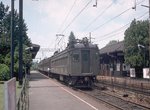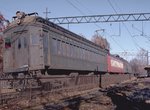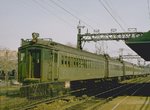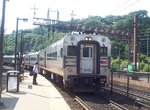New Jersey Transit Morris and Essex Line
![]()
New Jersey Transit Arrow III EMU train on the Morris & Essex Line at Denville. Photo by Chris Reidy, April 2008.
Overview
We will begin our tour of New Jersey Transit's Morris and Essex lines at the junction with the Northeast Corridor line, known as the "Midtown Direct" connection. This connection was a major project aimed at unifying NJ Transit's heavy rail system into one unified network. Originally named the Kearny Connection, it was swiftly renamed to more properly indicate the function of the connection for marketing purposes. The trains that use the connection must be hauled by NJT's voltage ALP-44 (and soon ALP-46) locomotives, which can switch from 12,000 to 25,000 volts on the fly. The rest of the Morris & Essex is served by electric multiple unit and even diesel-hauled locomotive trains.
Station By Station
Trains on the Morris & Essex now have two choices of terminal: Hoboken, and New York-Penn Station, which is described on the New Jersey Transit Northeast Corridor Line page.
Leaving the Northeast Corridor line, the three-track main line parallels Interstate 280 on the north side and the Northeast Corridor line to the south. Crossing the Passaic River on a two-track drawbridge, we spot the Newark Bears minor league baseball team, and quickly enter Newark Broad Street, which has two low side platforms and a center bypass track. There are large wooden station houses on each platform and crossunders to the main station at street level. Railings are ornate wrought iron. There is evidence of some closed exits to the street.
East Orange follows, on a viaduct. There are three tracks, with a low-level island platform serving the eastbound and center tracks and a side platform serving westbound trains. The platforms have been shortened and evidence of their former length is clearly visible at the ends of the platforms. The next station is nearly identical, Brick Church.
Next up is Orange, featuring two side platforms alongside three tracks. The station was moved from its original location further to the west. There is an indoor waiting area on both platforms, and the main station house is on the south side of the tracks. An extra exit to the street is located at the east end of both platforms. Highland Avenue follows, also two low wall platforms and a center bypass track.
Mountain Station is next. The platform arrangement is the same as Orange. A mission style station house is located on both platforms. The east end of the station is partially in an arched tunnel due to the street passing overhead. South Orange is next, with a low island serving the center and westbound track and a low side platform serving eastbound trains. A mission style station house is on both platforms. A sign proudly proclaims the station as the "Home of Seton Hall University."
Maplewood is next. A low island serves the center and westbound track and a low side platform serves the eastbound track. The main station house serves eastbound trains and is a nice Tudor style building. There is a crossunder and a mini-station house for westbound trains. A maple leaf pattern is located on the walls of the crossunder to the island platform.
The line becomes two tracks and we continue our ride. Millburn is next with two low wall platforms. The current station house is on the south side. This is a modern building with marble walls, lots of glass and a 45-degree angle glass skylight. An old station house on the north side has been converted to a private law office. Short Hills follows, with two low side platforms. The north side had a station house, which is now the home of the Short Hills Historical Society.
Summit is next, and is the first station along the line to feature high platforms. An island serves the eastbound and and center track and a wall platform serves westbound trains. This nice station is in a cut with concrete sidewalls. There is a station house and crossover over the tracks and is A.D.A.-compliant. This station serves as the terminal of some local trains from Hoboken, as well as non-through service from the Gladstone branch.
Morristown Line
Chatham is next. This station is on an embankment and has two low wall platforms. Station houses are on both platforms but the north side house is closed. Madison follows, raised on a viaduct through town. There are two low platforms with stone station houses on both platforms. The eastbound side has an extra closed station house. Side rails of the platforms are concrete, as are the canopies.
Convent Station follows and is located at a grade crossing with two low platforms. The station has a station house on each platform with the north side being closed. A sign proclaims the station as "Home of the College of Saint Elizabeth." The college can be seen just to the north and east of the station. There are a few more grade crossings immediately to the west of Convent Station.
Morristown is next and we return to grade separation via embankment over the street. There are closed station houses on both low wall platforms. There is a crossunder as well as a ramp to the parking area to the south of the eastbound platform.
Morris Plains is next, grade separated with two low wall platforms. An old station house to the west of the station on the south side is now a model railroad club. This station has a crossunder and a mini-high platform on the east end.
Mount Tabor follows, with two low side platforms that are very short. There is a grade crossing on both sides of the station, and stopping trains will block the crossing. Not all trains serve this little station.
Denville follows. This station has two low side platforms with mini-high platforms on the east end. Denville is also served by Boonton line trains which connect via a single track line from the northeast. Those trains stop at a has a separate high platform adjacent to that track.
We arrive at Dover after a local-stops ride of almost ninety minutes. Recently rebuilt, Dover has two tracks and a high center island platform. The station formerly had three tracks and a low platform on the north side only. A grade crossing is west of the station, which has two tracks and a high island platform. Electric trains from Hoboken and New York must terminate here, however the diesel Boonton line trains continue to Hackettstown. A storage yard for electric trains is to the east of the station on the south side.
Gladstone Line
Photo Gallery
| Five Random Images | ||||
 Image 20615 (230k, 1024x670) Photo by: Steve Zabel Collection of: Joe Testagrose Location: Chatham |  Image 20665 (221k, 1024x662) Photo by: Steve Zabel Collection of: Joe Testagrose Location: Maplewood |  Image 20756 (220k, 1024x691) Photo by: Steve Zabel Collection of: Joe Testagrose Location: Harrison |  Image 86402 (275k, 1044x786) Photo by: Chris Reidy Location: Denville |  Image 91235 (295k, 1044x786) Photo by: Chris Reidy Location: Dover |
Photos By Location
Photo locations: Bergen Tunnel - East Portal, Bergen Tunnel - West Portal, Harrison, Newark Broad Street, East Orange, Brick Church, Orange, Highland Avenue, Mountain Station, South Orange, Maplewood, Millburn, Short Hills, Summit, Chatham, Madison, Convent Station, Morristown, Morris Plains, Mt. Tabor, Denville, Dover, Mt. Arlington, Lake Hopatcong, Netcong, Mt. Olive, Hackettstown, New Providence, Murray Hill, Berkeley Heights, Near Berkeley Hts, Gillette, Stirling, Millington, Millington High Bridge, Millington Quarry, Lyons, Basking Ridge, Bernardsville, Far Hills, Peapack, Gladstone
Page Credits
By Peggy Darlington.